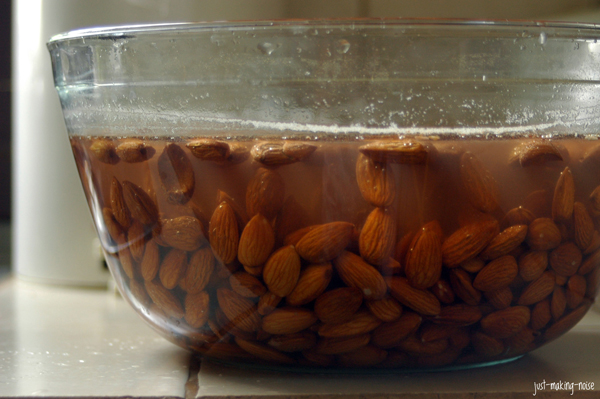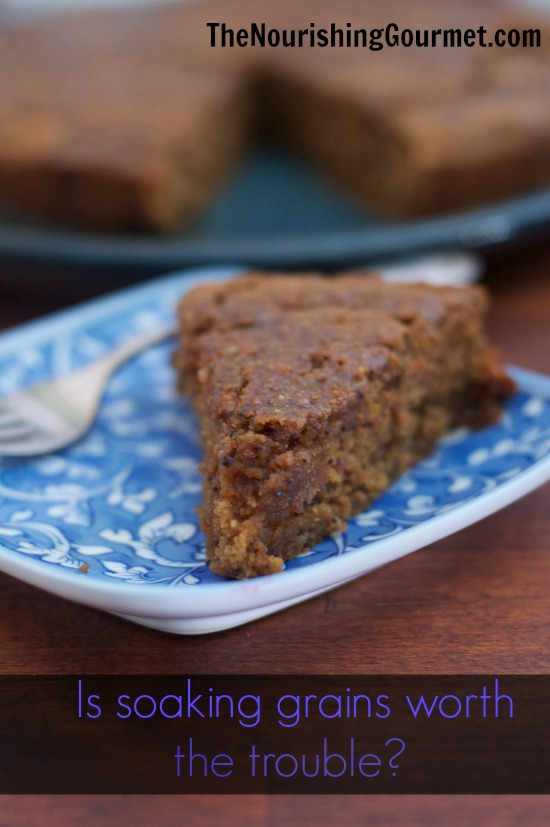By Marillyn Beard, Contributing Writer
We all know how healthy nuts and seeds can be, but I used to cringe at them growing up. I wasn’t fond of the waxy, slightly bitter taste or the bland texture. My parents often put out a bowl of trail mix… I would always eat the M&M’s and dried fruits instead of the nuts. When I did force myself to eat a handful or two, I didn’t like how I felt afterwards… my stomach would sometimes feel heavy & aching. My head would hurt. My mouth sometimes felt funny and I often got tired & cranky.
I was told these guys were supposed to be healthy and a great source of energy for those who were active in sports!! Not so for me. I thought it was because I’m more of a “carb” person and couldn’t handle a lot of protein.
Fast forward to several years later, through research I learned that I was basically experiencing mild nut/seed allergies and that my body was telling me my digestive system was under a lot of stress trying to digest them.
Now, I can digest and throughly enjoy nuts with no problems! Allow me to share with you, as part of our 21 steps to a nourishing diet series, what I learned about nuts & seeds and touch on three of the ten reasons why properly preparing them is vital.
KNOW YOUR NUTS AND SEEDS
Did you know that raw nuts and seeds have defense mechanisms made up of enzyme inhibitors, toxic substances (tannic acid & goitrogens) and phytic acid?
Yep, these natural components are there for their protection. Nature doesn’t want the seed to germinate prematurely or predators to consume them to the point where they become extinct. It is amazing how God designed nuts & seeds to have these defense mechanisms so they can continue to bring forth new plants for many, many years! Those natural components can be removed naturally only when there is enough moisture to sustain a new plant after the nut or seed germinates.
WHAT’S THE BIG DEAL ABOUT PHYTIC ACID, GOITROGENS & ENZYME INHIBITORS?
The biggest defense mechanism in nuts & seeds is the phytic acid. Every nut & seed have different levels of phytic acid with almonds, brazil nuts and sesame seeds having the highest percentage. When something that contains phytic acid is eaten, the acid binds itself to minerals like iron, magnesium, zinc, calcium, manganese and chromium in the gut, which prevents the digestive system’s ability to break the nut or seed or grain down properly (that’s why, often, when you eat nuts or seeds… you see undigested bits in your stool the very next day!).
If you struggle with anemia, low zinc levels, osteoporosis and other illness related to low mineral absorption… you should not be eating unsoaked nuts, especially walnuts, almonds & peanuts.
Recently, my grandfather was admitted into the hospital for extremely low hemoglobin. One habit my grandfather has, that I believe is one of the causes of his low hemoglobin & other health issues, is he eats several handfuls of raw/roasted nuts & seeds every day and has done so for years. He believes they are good sources of protein and energy, but they are really causing him more health issues and stealing away his lifespan & energy. For him and everyone else, soaking will help break down the phytic acid and increase the nutritional value without taking away vital nutrients needed for him to be healthy in his old age.
Even though phytic acid is the big, bad guy in nuts and seeds… goitrogens & enzyme inhibitors should not be overlooked either.
Goitrogens is are known to suppress the function of the thyroid gland by interfering with iodine uptake, which can cause a goiter (enlargement of the thyroid), slow down the thyroid, hypothyroidism and other autoimmune thread disorders. Soaking helps reduces goitrogens and actually increases the necessary minerals needed for a healthy thyroid!
Enzyme inhibitors neutralizes vital enzymes that your body naturally produces and can lead to many illnesses that results of an unhealthy, enzyme-depleted gut. Signs that your body is lacking enzymes are bloating, constipation, diarrhea, heartburn, irritable bowels and gas. A lack of just one enzyme in the body can lead to many problems and you will only live as long as your body has enzymes… which is why it is important to neutralize the enzyme inhibitors to keep them from decreasing your body of its natural enzymes. Soaking increases the natural enzymes within the nuts & seeds, helps provide greater absorption of the its’ nutrients and increases digestibility.
Basically, when you eat raw nuts or seeds or grains that have not be properly prepared… those “healthy” morsels are actually robbing you of vital minerals, vitamins and enzymes needed to sustain a healthy body!
I feel we should respect those defense mechanism by properly soaking nuts and seeds before consuming them.

HOW TO PROPERLY PREPARE NUTS & SEEDS IN 3 SIMPLE STEPS
All you need to do is mimic nature’s germination system and give those nuts & seeds a good soak to deactivate the phytic acid, giotrogens and enzyme inhibitors!
You can make sure those natural components get properly minimized or eliminated by following these 3 simple steps:
1. Add your nuts/seeds to a glass jar or bowl and mix warm water & sea salt (make sure there’s enough water to cover the nuts completely). Soak them for the time required.
2. When done soaking, drain out the soak water and thoroughly rinse the nuts.
3. You can do one of two things: refrigerate the soaked nuts and consume within 24 hours OR dry in a dehydrator (or in oven set on the lowest temperature). Store in an airtight container.
Important note: The soak water should always be discarded and never used as water in a recipe or given to your animals.
HOW SOAKING WORKED FOR ME
Soaking & dehydrating nuts and seeds was one of the first things I learned to do after reading Nourishing Traditions and we decided to start up the path of preparing our food more traditionally to improve our overall health. I wanted to see if it would really make a difference and if I could tolerate nuts after being soaked & dehydrated. Honestly, I was a little skeptical.
It was my very first bite that won me over.
My first bite of an almond right out of the dehydrator was deliciously sweet & crunchy. I grabbed another and another and another and soon I was sitting at my kitchen table with a bowlful of warm, sweet, crunchy almonds. After indulging, I got nervous that I was going to have my usual reactions even though I normally start feeling them almost right away.
10 minutes passed… nothing.
20 minutes passed… felt great.
30 minutes passed… felt great and energetic.
An 1 hour passed and I still felt great! I was thrilled!
Of course, I ordered some walnuts and pecans to try next. These were my least favorite nuts, but after taking them through the 3 simple steps… I was won over by their wonderful buttery taste and crunchy texture. That is one of the many reasons why I am still faithfully soaking and dehydrating our nuts and seeds over 7 years later! It has become a normal routine where I would buy nuts & seeds in bulk once a month and follow my 3 simple steps. All that prep takes me less than 10 minutes!
I can say that it has made a difference to our overall health and my kids do not like to eat nuts or seeds that have not be properly prepared. They know the difference between raw & un-soaked nuts to raw & soaked nuts by their flavor, texture and how they feel after eating them.
Think you are ready to take on the easy challenge of soaking your nuts and seeds?? Your gut will profusely thank you if you did!

- Nuts and seeds of your choice
- Warm water
- Sea Salt (I use at least 1 Tbsp per 2 Lbs of nuts/seeds)
- Add your nuts or seeds to a glass jar or bowl and mix in warm water & sea salt (make sure there's enough water to cover the nuts completely). Soak them for the time required.
- When done soaking, drain out the soak water and thoroughly rinse the nuts.
- You can do one of two things: refrigerate the soaked nuts and consume within 24 hours OR dry in a dehydrator (or in oven set on the lowest temperature). Store in an airtight container.
10 RECIPES USING SOAKED NUTS & SEEDS
Cherries & Sunshine Trail Mix (grain-free)
Flourless Chocolate Almond Cookies (grain-free)
Honey Almond Dream w/ Blackberry Sauce
Spicy Ginger Snaps (grain-free)
Grain-free Apple Elderberry Crumble Cake
Almond Cookies (Made with whole, soaked and dehydrated almonds)
Apple Cinnamon Nut Granola (Grain-free)
Nourishing Traditions by Sally Fallon
Food Enzymes for Health & Longevity by Dr. Edward Howell
http://www.whfoods.com/genpage.php?tname=george&dbid=250
http://www.westonaprice.org/food-features/living-with-phytic-acid
http://www.lef.org/protocols/prtcls-txt/t-prtcl-044.htm
http://science.howstuffworks.com/life/cellular-microscopic/cell2.htm
http://www.ajcn.org/content/47/2/270.full.pdf
